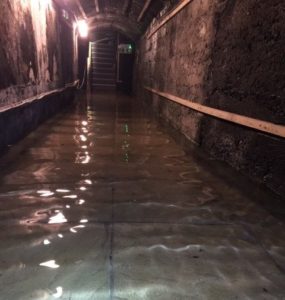2016 – Present
The centre is put up for sale and sold for £1.35 million in November 2016. With the acquisition in 2017, there’s many exciting plans to ensure that the museum continues to inspire, challenge, and captivate in equal measure, and so the renovations begin…
The underground tunnels grow with extensions, the shop is refurbished, exhibits are developed, brand-new shops and restaurants join the crew, custom artwork and stained windows add a splash of colour inside, and it’s finished with a swanky new paint job outside to tie everything together as the Merchants of Charlestown.
 As with any shipwreck story, ours too had its share of difficulty, ingenuity and pioneering. From the rough seas of COVID to a few ironic floods, it’s been a little choppy in places, but nothing our expert crew can’t handle!
As with any shipwreck story, ours too had its share of difficulty, ingenuity and pioneering. From the rough seas of COVID to a few ironic floods, it’s been a little choppy in places, but nothing our expert crew can’t handle!
More daring explorers dive in than ever before and the museum becomes the second oldest tourist attraction in Cornwall!

 As with any shipwreck story, ours too had its share of difficulty, ingenuity and pioneering. From the rough seas of COVID to a few ironic floods, it’s been a little choppy in places, but nothing our expert crew can’t handle!
As with any shipwreck story, ours too had its share of difficulty, ingenuity and pioneering. From the rough seas of COVID to a few ironic floods, it’s been a little choppy in places, but nothing our expert crew can’t handle!